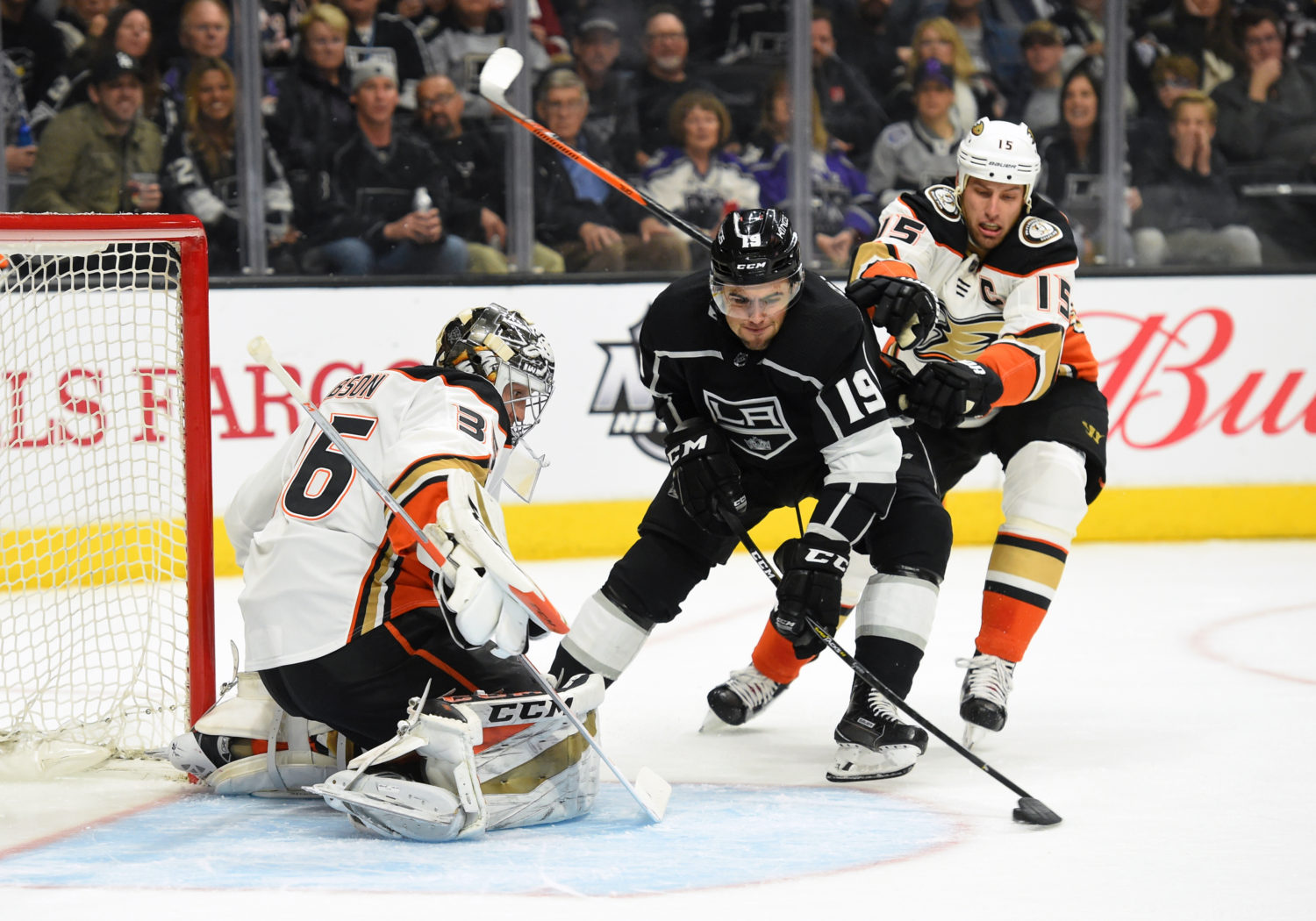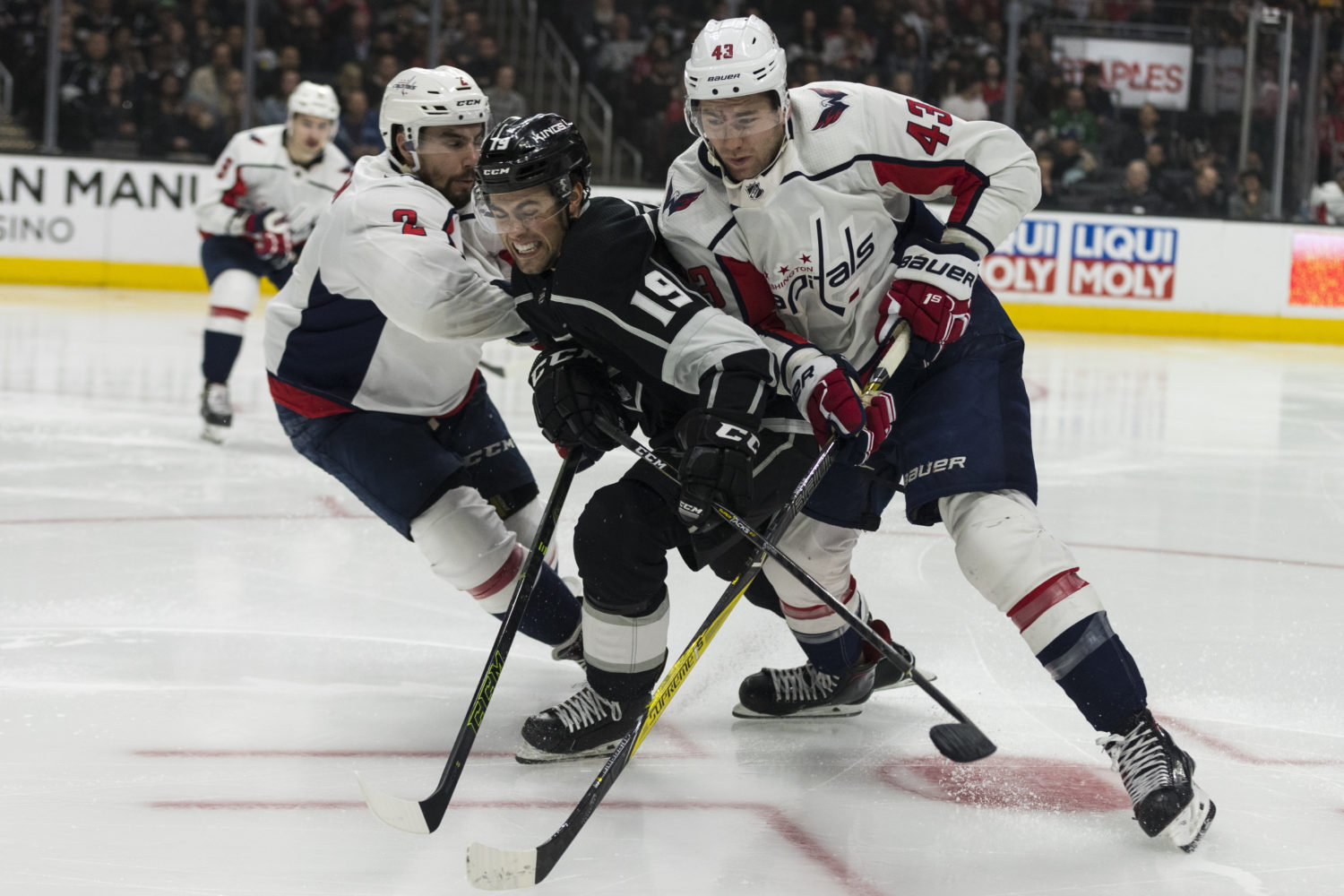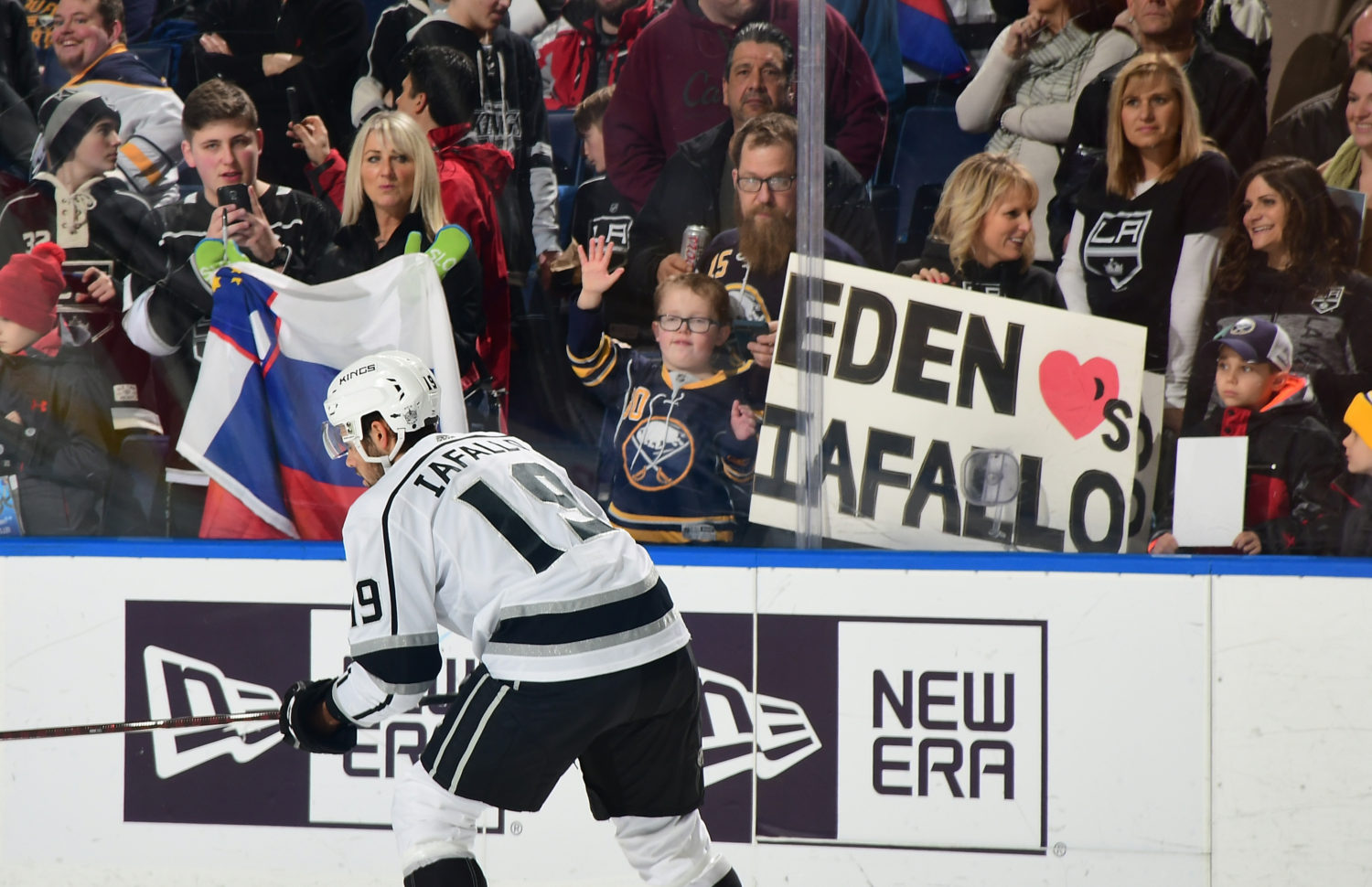This season: 75 games, 9 goals, 16 assists, 25 points, 12 penalty minutes, +10 rating, 129 shots, +3.2% CF%Rel, 1.010 PDO, 15:06 time on ice
The good: While his future teammates nursed jet lags two days after returning from China, Alex Iafallo, becoming increasingly poised to claim a spot on the team, was outstanding in a preseason game at T-Mobile Arena in Las Vegas, forechecking Nate Schmidt off the puck to set up Brooks Laich for the overtime game-winner. From that moment on, he never at any point let up on his command of a roster spot and ended up spending the better part of the next 80-plus games alongside Anze Kopitar and Dustin Brown as part of a resurgent Kings top line. Though the scouting and recruiting forces had kept close tabs on him, the summer of 2017 was really the first time John Stevens became familiar with Iafallo, and from development camp through rookie camp and then training camp, the Buffalo-area native continued to pass all the tests asked of him and quickly grew some impressive trust in the new coaching staff. Turning 24 midway through the season, Iafallo is young, even if he isn’t an infant by NHL standards. Providing an immediate and sorely needed impact at bargain value, Iafallo’s speed and puck pursuit allowed him to forecheck and win back pucks in the offensive zone, increasing the team’s zone time and affording Kopitar and Brown additional opportunity. Less than a month into the season, Stevens noted that “if there’s a third assist in hockey, [Iafallo would] have a lot of them.”
Having torn the meniscus in his right knee during his final USHL season, Iafallo ultimately gained a jump in his quickness early in his tenure at Minnesota-Duluth and credited a lopsided amount of lower-body work for his improvement as a skater. “After that, juniors on, I just used my speed as my main asset for forechecking, backchecking, getting the pucks in the corners. Ever since then, everybody’s been saying just to keep my speed up,” he said. Combined with his excellent support, positioning and detail, his speed and pacing aided his forechecking and allowed him to serve as a tried and true puckhound who meshed well with Kopitar and Brown, even when he wasn’t putting up the level of points befitting a first line left wing. “There’s not a lot of learning process – it’s not that,” Kopitar said. “He goes in and he plays his game.” His shot metrics and advanced stats, while buoyed by his play alongside traditional play-driving stalwarts, were excellent. He saw defensively-skewed zone starts against the league’s best competition, and played a significant role in the top line’s ability to disproportionately play in the attacking end. He spent the lion’s share of his minutes alongside Kopitar and Brown, but the team actually pushed play to the attacking end to a greater degree in the scant opportunity Iafallo was away from the stellar duo. It’s not particularly important, but the team actually posted significantly better possession rates when Iafallo was used apart from Kopitar, Drew Doughty, Derek Forbort and Jake Muzzin than the completely fine metrics posted when he was used alongside them. That may not come off overwhelmingly positive, but it shows that Iafallo was tugging his own share of the possession rope and wasn’t simply a beneficiary of the tremendous talent he was playing alongside. It also suggests that should there be different context in his teammates and competition this year – a safe bet, considering Ilya Kovalchuk was signed to absorb a good deal of the minutes Iafallo had previously played – he should still provide a good push towards productive efforts that show up both on the scoreboard, and, perhaps more pronounced, on the spreadsheet.
Even as a six-foot, 185-pound rookie, Iafallo was right at home in the more rugged aspects of Pacific Division play. Some of his best minutes of the season were logged against Anaheim, a heavy opponent against whom he posted one goal, four points and 11 shots on goal in four games. Clearly, Iafallo is the type of player who will find a home in the new NHL as an aggressive forechecker who is hard on pucks, fights to win them back and is crafty in smaller spaces. It’s not too different from the type of ability Justin Williams showed in the offensive zone, though Iafallo doesn’t quite have the same degree of skill level as Williams, a former first round pick who posted 31 goals in his 24-year-old season. But even when he wasn’t in the attacking zone, he was very useful as an adept backchecker and stick-lifter, which came in handy in setting up Kopitar and Brown in the other direction. He was voted by the media as the Mark Bavis Memorial Award winner as the team’s best newcomer.
The bad: Nothing glaring. There’s the basic question of whether there’s an untapped spring of production, or if 2017-18 was essentially What You See Is What You Get. There were bouts of inconsistency, as there would be with any player making the jump straight from playing 40-plus games a year in the NCAAs to playing 80-plus in the NHL. In December, during the twilight of a nine-game stretch in which he was held without a point, Stevens spoke about the “12 feet of ice along the wall that’s going to define your career,” which suggested some mid-season inconsistency in Iafallo’s perimeter play. “If you can be comfortable along the wall in those areas, pucks are coming to you, and you’re ready to either take on contact, make a play, move your feet, chip a puck, I just think there are areas around the wall there that when he’s really on, it just seems like he’s really sharp and makes those plays, and then when he’s not as sharp, I think those are pucks that either go by him or don’t get out of the zone.” Promisingly, Iafallo seemed to take the instruction well. He was a healthy scratch for back-to-back games in early January before returning to the lineup to post two goals and five points in his first nine games back and appeared to benefit from the breather midway through his first full professional season. After dealing with an upper-body injury late in the season, he returned for the playoff opener but was ineffective. He was held out of Game 2 before returning and scoring a Game 3 goal that held up as one of the team’s three playoff markers. Though his shot showed improvement (and was clearly one of his strongest assets in college), it’s not yet clear if it’s good enough to produce regular 15-to-20 goal seasons.
Going forward: Having gained cult figure status early in his Kings and professional tenure, the challenge for Iafallo will be building on his 2017-18 numbers and metrics while spending more time with “middle six” players instead of Kopitar and Brown. We’re still two-plus months away from sharing line combinations that hold any water, but it would appear that Kovalchuk has a welcome mat laid out in that 1LW slot. As effective as Iafallo was there, that’s understandable; Kovalchuk, whose power play production the team is also banking on, should have no trouble breezing past Iafallo’s 22 5×5 points should he remain healthy. Still, all metrics and most eye tests indicated that Iafallo was at worst plenty serviceable on the Kings’ top line, and at times a clear, possession-maintaining boon.
So much of what was seen from Iafallo in his debut season was foretold, to some extent, by Jack Ferreira – now Paul Fenton’s right-hand man in Minnesota – who stated early in training camp that the forward was going to play immediately in the NHL. But before Ferreira, there was also the familiarity and bond built between Mark Yannetti, Tony Gasparini and Teddy Belisle and Iafallo’s family during his recruitment, when the Kings practically set up a scouting office in Duluth, Minnesota. Their eyes on Iafallo, their appreciation of his detail-oriented play and belief that he’s “the type of young man that the Kings have had success developing into NHL players,” according to Gasparini, served to provide a player who made an immediate impact, thus providing sturdier than expected lineup balance and making obsolete Michael Cammalleri, who was signed to play in the top-six before it was clear the Kings already had their own internal option there. Los Angeles benefited greatly by playing a $925,000 cap hit alongside the two weightiest forward contracts, and as someone with one year remaining on his entry-level contract, Iafallo will need to continue to provide dividends for a team bumping its head against the salary cap ceiling. With only one year of data available, there’s still some range in what a season alongside players who aren’t Kopitar and Brown could look like. But there’s enough detail, positioning and work ethic to back up some awfully impressive data, suggesting an appropriate role in waiting as a responsible third-line winger who can contribute much-needed speed, pacing and secondary scoring — and move up the lineup if needed.
Player evaluations: #3 DION PHANEUF | #6 JAKE MUZZIN | #7 OSCAR FANTENBERG | #8 DREW DOUGHTY | #9 ADRIAN KEMPE | #11 ANZE KOPITAR | #13 KYLE CLIFFORD | #19 ALEX IAFALLO | #22 TREVOR LEWIS | #23 DUSTIN BROWN | #24 DEREK FORBORT | #27 ALEC MARTINEZ | #32 JONATHAN QUICK | #44 NATE THOMPSON | #52 MICHAEL AMADIO | #70 TANNER PEARSON | #73 TYLER TOFFOLI | #77 JEFF CARTER | KUEMPER / CAMPBELL | THE OTHERS
-Advanced stats via Natural Stat Trick, Corsica
-Lead photo via Chris Williams/Icon Sportswire






Rules for Blog Commenting
Repeated violations of the blog rules will result in site bans, commensurate with the nature and number of offenses.
Please flag any comments that violate the site rules for moderation. For immediate problems regarding problematic posts, please email zdooley@lakings.com.